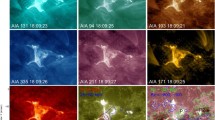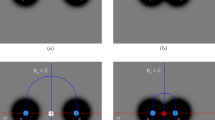Abstract
We discuss footpoints of loops seen by Yohkoh in soft X-rays that connect active regions across the equator (transequatorial interconnecting loops – TILs). While most TILs are rooted in moderately strong fields at peripheries of active regions, there are also cases when these loops are anchored in very weak or very strong fields, ranging from < 30 G to several hundred gauss. Some have their footpoints near sunspot penumbrae, creating `X-ray fountains' in a combination with active region loops. But TILs are never rooted in sunspots. The most likely explanation is that magnetic field lines leave spots almost vertically so that TILs rooted in them extend high into the corona and density in them is below the limit of visibility in X-rays. The fact that in force-free modeling some TILs are rooted in sunspots is most probably due to the difference between field-line connections in `vacuum' and in the highly conductive plasma on the Sun. Some TILs end before they reach active regions which sometimes may indicate the real situation, but mostly this `gap' is probably due to a temperature decrease near the loop footpoints which makes them invisible in X-rays. In that case the fact that these cool lowest parts of TILs are never found in TRACE or SOHO EIT images indicates that plasma density in TILs must be very low. Still, the total absence of any counterparts of X-ray TILs in TRACE and EIT images is puzzling and, therefore, other possible interpretations of the `gap' origin are also briefly mentioned.
Similar content being viewed by others
References
Alissandrakis, C. E.: 1981, Astron. Astrophys. 100, 197.
Chase, R. C., Krieger, A. S., Švestka, Z., and Vaiana, G. S.: 1976, Space Res. XVI, 917.
Démoulin, P., Bagala, L. G., Mandrini, C. H., Hénoux, J. C., and Rovira, M. G.: 1997, Astron. Astrophys. 325, 305.
Fárník, F., Karlický, M., and Švestka, Z.: 1999, Solar Phys. 187, 33.
Fárník, F., Švestka, Z., Karlický, M., and Hudson, H. S.: 1999, Proceedings 8th SOHO Workshop, ESA SP-446, p. 305.
Fárník, F., Varady, M., Švestka, Z., Hudson, H., and Fludra, A.: 2000, 'Variability and Physical Properties of Transequatorial Interconnecting Loops', Yohkoh, SOHO, TRACE JOP 119.
Handy, B. N., Acton, L. W., Kankelborg, C. C., Wolfson, C. J. and 44 co-authors: 1999, Solar Phys. 187, 229.
Howard, R. and Švestka, Z.: 1977, Solar Phys. 54, 65.
Levine, R. H., Altschuler, M. D., Harvey, J. W., and Jackson, B. V.: 1977, Astrophys. J. 215, 636.
Schrijver, C. J. and 16 co-authors: 1999, Solar Phys. 187, 261.
Švestka, Z., Krieger, A. S., Chase, R. C., and Howard, R.: 1977a, Solar Phys. 52, 69.
Švestka, Z., Solodyna, C. V., Howard, R., and Levine, R. H.: 1977b, Solar Phys. 55, 359.
Tsuneta, S.: 1996, Astrophys. J. 456, L63.
Tsuneta, S., Acton, L., Bruner, M., Lemen, J., Brown, W., Caravalho, R., Catura, R., Freeland, S., Jurcevich, B., Morrison, M., Ogawara, Y., Hirayama, T., and Owens, J.: 1991, Solar Phys. 137, 37.
Author information
Authors and Affiliations
Rights and permissions
About this article
Cite this article
Fárník, F., Karlický, M. & Švestka, Z. Locations of Footpoints of Transequatorial Interconnecting Loops. Solar Physics 202, 81–98 (2001). https://doi.org/10.1023/A:1011812000475
Issue Date:
DOI: https://doi.org/10.1023/A:1011812000475




